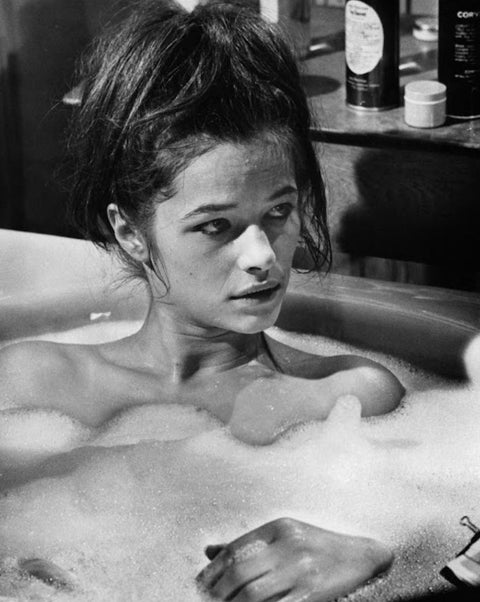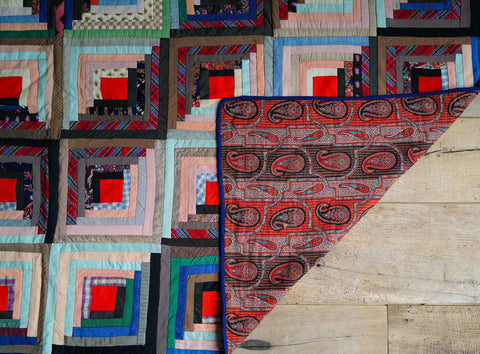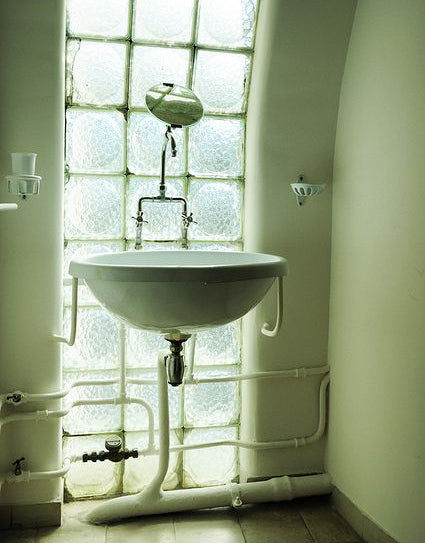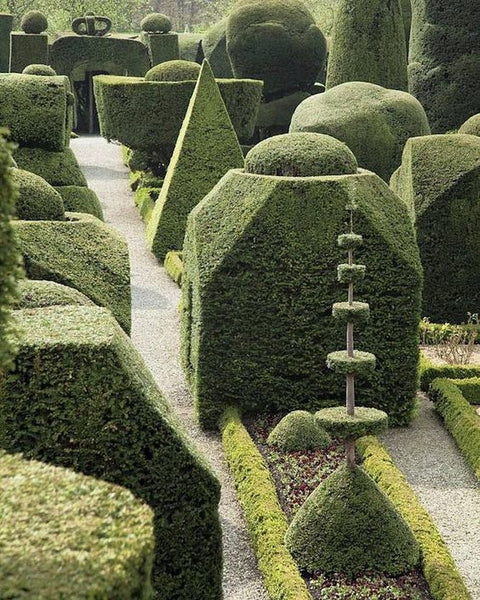
BATH TIME ON THE SILVER SCREEN
Interior designers are always seeking to create the emotional charge that comes from a particular space. Filmmakers are doing the same within a fictional world of their creation, expressed through the characters interacting through an environment. Often in film, the bathroom becomes a visual backdrop for a moment of vulnerability, whether emotional or physical. We see the bathroom in a fraught or intimate moment between lovers or just before a murder in a horror film. It’s a similarly a place for a sexy main character to show off their body without the feeling that they are showing it off. The details in a bathroom convey the very essence of the character, their personality, the moment in time they inhabit, the state of their affairs, and their inner world.
Barry Lyndon directed by Stanley Kubrick, 1975
“He embraced the challenge to create on film what used to be the exclusive domain of painters.” - Jan Harlan
This masterpiece of film making by Stanley Kubrick, follows the rise and fall of the ‘Irish rogue’ Barry Lyndon, a wily yet inherently flawed character who climbs up through the echelons of the British class system like a monkey in a playground.
Kubrick famously studied paintings by Hogarth and Gainsborough of the same period to construct his shots. He and his team painstakingly recreated the intricate social codes of the period preserved in these works of art and brought to them to life again through the medium of film. Though shot in the 70s, the age of synthetic materials, Kubrick only used pure silk fabrics in the costumes (the fabric had to have been able to be made in the period) and also shot scenes using only natural light or candles.

We love Lady Lyndon's Austrian shade curtains backlit by the large Georgian windows and the wicker bath encasement inspired by Napoleonic rattan work of the period.
8 1/2 directed by Federico Fellini, 1963
In 8 1/2 by Fellini, a self-reflexive film about the challenges of remaining true to one's art, we see the tortured Marcello Mastroianni fumbling his way through a creative block. He checks into a spa to escape his self-incurred stresses.

In this scene Mastroianni is desperately seeking guidance. Like a room of religious old sages, the men gather, quietly conversing. The pacing in this space, smoke drenched light and simple atmosphere does not produce the answers Mastroianni is hoping for and he leaves with the same unease that follows him throughout the film.
The stark architecture and repetitive perspective lines with ghostly figures wrapped in towels suggest a kind of religious order.
The Cook, the Thief, His Wife and Her Lover directed by Peter Greenaway, 1989
This deeply unsettling yet masterful film stars Helen Mirren with costumes by fashion superstar, Jean Paul Gaultier. The film uses extreme colour saturation throughout to set the emotional timbre for each scene.

During a particularly intense dinner, marked by a vivid red, Mirren escapes to the bathroom, at which point her red dress becomes white. She becomes one with the austere and controlled setting of the minimal yet Deco environs. The clear repetition of the cubicle doors, the arches in the architecture and the bathroom mirrors all reflect her internal landscape where she is regaining her steely composure.
Diamonds are Forever directed by Guy Hamilton, 1971
James Bond is one of the most stylistically built characters of the 20th century - his persona is more defined by his clothing, his accessories, his environments than by what he actually says. The sets for the most famous Bond film, at the height of the golden age of filmmaking needed to be exceptional. In this seminal scene, we get a sense that we are voyeuristically peering into the world of an impeccably elegant gentleman. His silver service perches on the edge of a round bath, detailed with a classic Greek key. All signifiers of his eminence as a human being, with a touch of the decadent.

The Oscar winning set designer, Kenneth Adams, was the son of an upper-middle class secular Jewish family from Berlin who fled to the UK following the outbreak of war. He became interested in film at a young age, via the many intellectual and creative Jewish refugees who boarded at his family’s home.
Pretty Woman directed by Gary Marshall, 1990
In this classic romcom, Vivian, Julia Robert’s character, has already slept with Edward (Richard Gere). However, her true personality starts to shine in the bath while she is singing along to her walkman’s headphones. Her character evolves from a prostitute who is just there to please, to a beguiling sweetheart, snagging the heart of Richard Gere in the process.

Another male fantasy, where the bath strips a woman of her facade revealing a kind, joyful and endearing woman, we find a Cinderella rags to riches fairytale. We know nothing about what drove her into prostitution but we can witness her evolution by how easily she is at home in the double tapped mega bath with its round window. Plush white bath towels frame her transition from object of desire to subject of love. It is this moment in the bath, where the love story truly begins.
The Dreamers directed by Bernardo Bertolucci, 2003
Confusing and intense relationships play out in The Dreamers by where siblings played by Eva Green and Louis Garrel explore a territory where innocence lacks boundaries. What starts as a somewhat strange but understandable family bath, turns into a moment that crosses taboos even within the adult world of sexuality that they are running headfirst into.

We love the Belle Epoque taps with the exquisite spigot that fill the freestanding bathtub, the unpretentious white field tiles, complimented by the perfect trifold mirror to catch the perplexed yet titillated expressions of Michael Pitt’s character.
The Seven Year Itch directed by Billy Wilder, 1955
Marilyn Monroe acts as the quintessential girl next door turned into male fantasy. Her bathroom screams 1950s optimism and enthusiasm for the new mass production of the time. Similarly, her clutter and towels suggest she is just a normal woman living in a New York apartment.

Though this is no ordinary woman, for she is the bombshell we all know as Marilyn Monroe. The interior is used to bring her back down to earth, a fantasy no less but a graspable one.
The Shining directed by Stanley Kubrick, 1980
In this scene, the highly stylised bathroom acts as a foil for a man looking at something he shouldn’t be looking at. He is tempted to go inside a door that has been left ajar of an uninhabited hotel room, the eery lighting draws him into the bathroom and the ghosts of the Overlook Hotel.

The decor of this room is so considered and so of its time. The smooth reflective surfaces suggest a well looked after space, where propriety reigns. However, we know this is not the case and discover in the film that the hotel is not just five star luxury but also the scene of a horrendous crime that cannot be brushed under the rug.
Delicatessen directed by Jean Pierre Jeunet and Marc Caro, 1991
The richly saturated world of Delicatessen has inspired a whole genre of filmmaking and interiors. This hilarious and macabre scene shows one of the many attempts by a miserable house wife to end her life, every time foiled by a series of events that are out of her control, suggesting a fatalistic idea that everything is connected.

Her bourgeois existence surrounded by the poverty of war is reflected in her pristine matching green water glasses perched perkily above her elegant pedestal sink, her tiling details and carefully painted pipework. It is clear that these creature comforts are only a contrast to her turmoiled inner landscape.
Performance directed by Donald Cammell and Nicolas Roeg, 1970
This extraordinary cult film starring Mick Jagger is known for its violence and sex, the meeting between the hard gangster world of 1970s London and the music scene.

Here we see Jagger and his co-stars bathing together in an equally extraordinary tiled bath. Hammam meets domestic bathroom. The extra details of the rubber duck, faux tortoise shell box, candy-floss coloured bubble bath in a cheap plastic bottle and next to an extra large bottle of Hermes Caleche just about sum it up.




